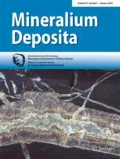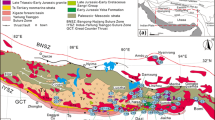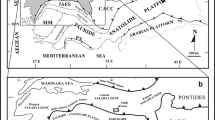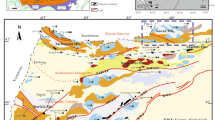Abstract
Neoproterozoic iron formations are exposed in the Wadi Hamama area (Egypt) in the northwestern part of the Arabian–Nubian Shield. Mafic and felsic volcanic and volcaniclastic rocks of an intra-oceanic island-arc setting host multiple, thin iron-formation units. Major element compositions of the iron formation confirm a low detrital input, whereas the rare-earth elements and Y data suggest deposition related to an influx of low-temperature hydrothermal fluids. Unlike most Neoproterozoic banded iron formations, but similar to other iron-formation occurrences from the Arabian–Nubian Shield, the Nd isotopic compositions of the Wadi Hamama iron formations are predominantly mantle-like. SIMS U–Pb zircon ages of the host volcaniclastic units indicate that the age of iron-formation deposition is ca. 695 Ma, which is within the Sturtian epoch that is presumed to be a glacial event of global extent. Nevertheless, there is no robust evidence of any influence of Sturtian glaciation in the Arabian–Nubian Shield. Our results rather suggest that the iron formations in the area may have formed as low-temperature exhalites on the floor of an island-arc basin. The iron formations were deposited during periods of volcanic quiescence, with metals having been derived during low-temperature pervasive hydrothermal alteration of volcanic and volcaniclastic rocks exposed at the seafloor–seawater interface. Precipitation took place due to mixing of metal-bearing hydrothermal fluids and cold, oxygenated seawater. There is no need to invoke possible effects of global glaciation to explain the origin of the Sturtian-aged iron formations in the shield. Our study thus suggests that not all Neoproterozoic iron formations are necessarily linked to glacial events as the Hamama deposit represents a non-Rapitan exhalative iron formation.













Similar content being viewed by others
References
Abd El-Rahman Y, Polat A, Dilek Y, Fryer BJ, El-Sharkawy M, Sakran S (2009a) Geochemistry and tectonic evolution of the Neoproterozoic incipient arc-forearc crust in the Fawakhir area, Central Eastern Desert of Egypt. Precambrian Res 175:116–134
Abd El-Rahman Y, Polat A, Dilek Y, Fryer BJ, El-Sharkawy M, Sakran S (2009b) Geochemistry and tectonic evolution of the Neoproterozoic Wadi Ghadir ophiolite, Eastern Desert, Egypt. Lithos 113:158–178
Abd El-Rahman Y, Polat A, Dilek Y, Kusky TM, El-Sharkawi M, Said A (2011) Cryogenian ophiolite tectonics and metallogeny of the Central Eastern Desert of Egypt. Int Geol Rev 54:1870–1884
Abd El-Rahman Y, Surour AD, El-Manawi AW, El-Dougdoug A, Omar S (2015) Regional setting and characteristics of the Neoproterozoic Wadi Hamama Zn-Cu-Ag-Au prospect: evidence for an intra-oceanic island arc-hosted volcanogenic hydrothermal system. Int J Earth Sci 104:625–644
Abdelsalam MG, Stern RJ (1996) Sutures and shear zones in the Arabian-Nubian Shield. J Afr Earth Sci 23:389–310
Ali KA, Stern RJ, Manton WI, Johnson PR, Mukherjee SK (2010a) Neoproterozoic diamictite in the Eastern Desert of Egypt and Northern Saudi Arabia: evidence of ~750 Ma glaciation in the Arabian-Nubian Shield. Int J Earth Sci 99:705–726
Ali KA, Stern RJ, Mantor WI, Kimura J-I, Whitehouse MJ, Mukherjee SK, Johnson PR, Griffin WR (2010b) Geochemical, U-Pb zircon, and Nd isotope investigations of the Neoproterozoic Ghawjah Metavolcanic rocks, northwestern Saudi Arabia. Lithos 120:379–392
Alt JC (1988) Hydrothermal oxide and nontronite deposits on seamounts in the Eastern Pacific. Mar Geol 81:227–239
Baldwin GJ, Turner EC, Kamber BS (2012) A new depositional model for glaciogenic Neoproterozoic iron formation: insights from the chemostratigraphy and basin configuration of the Rapitan iron formation. Can J Earth Sci 49:455–476
Basta FF, Maurice AE, Fontboté L, Favarger PY (2011) Petrology and geochemistry of the banded iron formation (BIF) of Wadi Karim and Um Anab, Eastern Desert, Egypt: implications for the origin of Neoproterozoic BIF. Precambrian Res 187:277–292
Bau M (1993) Effects of syn- and post-depositional processes on the rare-earth element distribution in Precambrian iron-formations. Eur J Mineral 5:257–267
Bau M, Dulski P (1996) Distribution of yttrium and rare-earth elements in the Penge and Kuruman iron-formations, Transvaal Supergroup, South Africa. Precambrian Res 79:37–55
Bau M, Dulski P (1999) Comparing yttrium and rare earths in hydrothermal fluids from the Mid-Atlantic Ridge: implications from Y and REE behavior during near-vent mixing and for the Y/Ho ratio of Proterozoic seawater. Chem Geol 155:77–90
Bekker A, Slack JF, Planavsky N, Krapež B, Hofmann A, Konhauser KO, Rouxel OJ (2010) Iron formation: the sedimentary product of a complex interplay among mantle, tectonic, oceanic, and biospheric processes. Econ Geol 105:467–508
Bekker A, Planavsky NJ, Krapež B, Hofmann A, Slack JF, Rouxel OJ, Konhauser KO (2014) Iron formations: their origins and implications for ancient seawater chemistry. In: Mackenzie FT (ed) Sediments, diagenesis, and sedimentary rocks. Treatise on geochemistry, vol 9, 2nd edn. Elsevier, Amsterdam, pp 561–628
Beukes NJ (1973) Precambrian iron-formations of South Africa. Econ Geol 68:960–1004
Beukes NJ, Gutzmer J (2008) Origin and paleoenvironmental significance of major iron formations at the Archean–Paleoproterozoic boundary. Rev Econ Geol 15:5–47
Blamey NJF, Brand U, Parnell J, Spear N, Lécuyer C, Benison K, Meng F, Ni P (2016) Paradigm shift in determining Neoproterozoic atmospheric oxygen. Geology 44:651–654
Bolhar R, Kamber BS, Moorbath S, Fedo CM, Whitehouse MJ (2004) Characterization of early Archean chemical sediments by trace element signatures. Earth Planet Sci Lett 222:43–60
Breitkopf JH (1988) Iron formations related to mafic volcanism and ensialic rifting in the southern margin zone of the Damara orogen, Namibia. Precambrian Res 38:111–130
Bühn B, Stanistreet IG, Okrusch M (1992) Late Proterozoic outer shelf manganese and iron deposits at Otjosondu (Namibia) related to Damaran oceanic opening. Econ Geol 87:1393–1411
Cabral AR, Moore JM, Mapani BS, Koubova M, Sattler CD (2011) Geochemical and mineralogical constraints on the genesis of the Otjosondu ferromanganese deposit, Namibia: hydrothermal exhalative versus hydrogenetic (including snowball-earth) origins. S Afr J Geol 114:57–76
Canfield DE, Poulton SW, Knoll AH, Narbonne GM, Ross G, Goldberg T, Strauss H (2008) Ferruginous conditions dominated later Neoproterozoic deep-water chemistry. Science 321:949–952
Chi Fru E, Ivarsson M, Kilias SP, Bengtson S, Belivanova V, Marone F, Fortin D, Broman C, Stampanoni M (2013) Fossilized iron bacteria reveal a pathway to the biological origin of banded iron formations. Nat Commun 4. https://doi.org/10.1038/ncomms3050
Cole DB, Reinhard CT, Wang X, Gueguen B, Halverson GP, Gibson T, Hodgskiss SW, McKenzie NR, Lyons TW, Planavsky NJ (2016) A shale-hosted Cr isotope record of low atmospheric oxygen during the Proterozoic. Geology 44:555–558
Corfu F, Hanchar JM, Hoskin PWO, Kinny P (2003) Atlas of zircon textures. Rev Mineral Geochem 53:469–500
Cox GM, Halverson GP, Minarik WG, Le Heron DP, Macdonald FA, Bellefroid EJ, Strauss JV (2013) Neoproterozoic iron formation: an evaluation of its temporal, environmental and tectonic significance. Chem Geol 362:232–249
Cox GM, Halverson GP, Poirier A, Le Heron D, Strauss JV, Stevenson R (2016a) A model for Cryogenian iron formations. Earth Planet Sci Lett 433:280–292
Cox GM, Halverson GP, Stevenson RK, Vokaty M, Poirier A, Kunzmann M, Li Z-X, Denyszyn SW, Strauss JV, Macdonald FA (2016b) Continental flood basalt weathering as a trigger for Neoproterozoic Snowball Earth. Earth Planet Sci Lett 446:89–99
Craddock PR, Bach W, Seewald JS, Rouxel OJ, Revees E, Tivey MK (2010) Rare earth element abundances in hydrothermal fluids from the Manus Basin, Papua New Guinea: indicators of sub-seafloor hydrothermal processes in back-arc basins. Geochim Cosmochim Acta 74:5494–5513
Danielson A, Möller P, Dulski P (1992) The europium anomalies in banded iron formations and the thermal history of the oceanic crust. Chem Geol 97:89–100
De Baar HJW, German CR, Elderfield H, van Gaans P (1988) Rare earth element distributions in anoxic waters of the Cariaco Trench. Geochim Cosmochim Acta 52:1203–1219
Derry LA, Jacobsen SB (1990) The chemical evolution of Precambrian seawater: evidence from REEs in banded iron formations. Geochim Cosmochim Acta 54:2965–2977
El Aref MM, El Dougdoug A, Abdel Wahed M, El Manawi AW (1993) Diagenetic and metamorphic history of the Umm Nar BIF, Eastern Desert, Egypt. Mineral Deposita 28:264–278
El-Shazly AK, Khalil KI (2014) Banded iron formations of Um Nar, Eastern Desert of Egypt: P-T-X conditions of metamorphism and tectonic implications. Lithos 196–197:356–375
El-Shazly AK, Khalil KI (2016) Metamorphic and geochronologic constraints on the tectonic evolution of the Central Eastern Desert of Egypt. Precambrian Res 283:144–168
Eyles N, Januszczak N (2004) ‘Zipper-rift’: a tectonic model for Neoproterozoic glaciations during the breakup of Rodinia after 750 Ma. Earth-Sci Rev 65:1–73
Fairchild IJ, Kennedy MJ (2007) Neoproterozoic glaciation in the earth system. J Geol Soc Lond 164:895–921
Feng L, Huang J, Lu D, Zhang Q (2017) Major and trace element geochemistry of the Neoproterozoic syn-glacial Fulu iron formation, South China. Geol Mag 154:1371–1380
Frei R, Gaucher C, Poulton SW, Canfield DE (2009) Fluctuations in Precambrian atmospheric oxygenation recorded by chromium isotopes. Nature 461:250–253
Freitas BT, Warren LV, Boggiani PC, De Almeida RP, Piacentinit T (2011) Tectono-sedimentary evolution of the Neoproterozoic BIF-bearing Jacadigo Group SW-Brazil. Sediment Geol 238:48–70
German CR, Holliday BP, Elderfield H (1991) Redox cycling of rare earth elements in the suboxic zone of the Black Sea. Geochim Cosmochim Acta 55:3553–3558
Grenne T, Slack JF (2003) Paleozoic and Mesozoic silica-rich seawater: evidence from hematitic chert (jasper) deposits. Geology 31:319–322
Grenne T, Slack JF (2005) Geochemistry of jasper beds from the Ordovician Lokken ophiolite, Norway: origin of proximal and distal siliceous exhalite. Econ Geol 100:1511–1527
Halverson GP, Poitrasson F, Hoffman PF, Nedelec A, Montel J-M, Kirby J (2011) Fe isotope and trace element geochemistry of the Neoproterozoic syn-glacial Rapitan iron formation. Earth Planet Sci Lett 309:100–112
Hassan YM (2005) Geology and mineralization of the Precambrian rocks at Wadi Hamama area, central Eastern Desert of Egypt. Unpublished MSc. thesis, Cairo University, Egypt
Hein JR, Hsueh-Wen Y, Gunn SH, Gibbs AE, Chung-ho W (1994) Composition and origin of hydrothermal ironstones from central Pacific seamounts. Geochimica et Cosmochimica Acta 58 (1):179-189
Hoffman PF, Abbot DS, Ashkenazy Y, Benn DI, Brocks JJ, Cohen PA, Cox GM, Creveling JR, Donnadieu Y, Erwin DH, Fairchild IJ, Ferreira D, Goodman JC, Halverson GP, Jansen MF, le Hir G, Love GD, Macdonald FA, Maloof AC, Partin CA, Ramstein G, Rose BEJ, Rose CV, Sadler PM, Tziperman E, Voigt A, Warren SG (2017) Snowball Earth climate dynamics and Cryogenian geology-geobiology. Sci Adv 3:e1600983
Hyde WT, Crowley TJ, Baum SK, Peltier WR (2000) Neoproterozoic “Snowball Earth” simulations with a coupled climate/ice-sheet model. Nature 405:425–429
Jacobsen SB, Pimentel-Klose MR (1988) Nd isotopic variations in Precambrian banded iron formations. Geophys Res Lett 15:393–396
Johnson PR, Andresen A, Collins AS, Fowler AR, Fritz H, Ghebreab W, Kusky T, Stern RJ (2011) Late Cryogenian–Ediacaran history of the Arabian–Nubian Shield: a review of depositional, plutonic, structural, and tectonic events in the closing stages of the northern East African Orogen. J Afr Earth Sci 61:167–232
Kato Y, Yamaguchi KE, Ohmoto H (2006) Rare earth elements in Precambrian banded iron formations: secular changes of Ce and Eu anomalies and evolution of atmospheric oxygen. Geol Soc Am Mem 198:269–289
Khalil KI, El–Shazly AE, Lehmann B (2015) Late Neoproterozoic banded iron formation (BIF) in the central Eastern Desert of Egypt: mineralogical and geochemical implications for the origin of the Gebel El Hadid iron ore deposit. Ore Geol Rev 69:380–399
Kirschvink JL (1992) Late Proterozoic low-latitude global glaciation: the Snowball Earth. In: Schopf JW, Klein C (eds) The Proterozoic biosphere. Cambridge University Press, Cambridge, pp 51–52
Klein C, Beukes NJ (1993) Sedimentology and geochemistry of the glaciogenic Late Proterozoic Rapitan iron-formation in Canada. Econ Geol 88:542–565
Klinkhammer GP, Elderfield H, Edmond JM, Mitra A (1994) Geochemical implications of rare earth element patterns in hydrothermal fluids from mid-ocean ridges. Geochim Cosmochim Acta 58(23):5105–5113
Koeppenkastrop D, De Carlo EH (1992) Sorption of rare-earth elements from seawater onto synthetic mineral particles: an experimental approach. Chem Geol 95:251–263
Lewis MJ, Asimow PD, Maurice AE, Fisher WW (2018) REE budget in a Neoproterozoic iron formation dominated by accessory apatite: Wadi Karim BIF, Eastern Desert, Egypt. Geological Society of America Abstracts with Programs 50. https://doi.org/10.1130/abs/2018AM-319589
Li ZX, Bogdanova SV, Collins AS, Davidson A, De Waele B, Ernst RE, Fitzsimons ICW, Fuck RA, Gladkochub DP, Jacobs J, Karlstrom KE, Lu S, Natapov LM, Pease V, Pisarevsky SA, Thrane K, Vernikovsky V (2008) Assembly, configuration, and break-up history of Rodinia: a synthesis. Precambrian Res 160:179–210
Li XH, Liu Y, Li QL, Guo CH, Chamberlain KR (2009) Precise determination of Phanerozoic zircon Pb/Pb age by multi-collector SIMS without external standardization. Geochem Geophys Geosyst 10:Q04010. https://doi.org/10.1029/2009GC002400
Li QL, Li XH, Liu Y, Tang GQ, Yang JH, Zhu WG (2010) Precise U-Pb and Pb-Pb dating of Phanerozoic baddeleyite by SIMS with oxygen flooding technique. JAAS 25:1107–1113
Li XH, Tang GQ, Gong B, Yang YH, Hou KJ, Hu ZC, Li QL, Liu Y, Li WX (2013) Qinghu zircon: a working reference for microbeam analysis of U-Pb age and Hf and O isotopes. Chin Sci Bull 58:4647–4654
Li CF, Chu ZY, Guo JH, Li YL, Yang YH, Li XH (2015) A rapid single column separation scheme for highprecision Sr–Nd–Pb isotopic analysis in geological samples using thermal ionization mass spectrometry. Anal Methods 7:4793–4802
Li XH, Abd El-Rahman Y, Abu Anbar M, Li J, Ling XX, Wu LG, Masoud AE (2018) Old continental crust underlying juvenile oceanic arc: evidence from northern Arabian-Nubian Shield. J Geophys Res 45:3001–3008
Ludwig KR (2001) User’s manual for Isoplot/ex rev. 2.49. Berkeley Geochronology Centre Berkeley, California, special publication b 1, 56p
Lyons TW, Reinhard CT, Planavsky NJ (2014) The rise of oxygen in Earth’s early ocean and atmosphere. Nature 506:307–315
Mclennan SM (1989) Rare earth elements in sedimentary rocks; influence of provenance and sedimentary processes. Rev Mineral 21:169–200
Miller RG, O’Nions RK (1985) Source of Precambrian chemical and clastic sediments. Nature 314:325–330
Nelson BK, DePaolo DJ (1985) Rapid production of continental crust 1.7 to 1.9 b.y. ago: Nd isotopic evidence from the basement of the North American mid-continent. Geol Soc Am Bull 96:746–754
Patchett PJ, Chase CG (2002) Role of transform continental margins in major crustal growth episodes. Geology 30:39–42
Peter JM (2003) Ancient iron formations: their genesis and use in the exploration for stratiform base metal sulfide deposits, with examples from the Bathurst Mining Camp. In: Lentz DR (ed) Geochemistry of sediments and sedimentary rocks: evolution considerations to mineral deposit-forming environments, vol 4. Geological Association of Canada, GeoText, pp 145–176
Pichler T, Veizer J (1999) Precipitation of Fe(III) oxyhydroxide deposits from shallow-water hydrothermal fluids in Tutum Bay, Ambitle Island, Papua New Guinea. Chem Geol 162:15–31
Piercey SJ, Peter JM, Herrington RJ (2015) Zn-rich volcanogenic massive sulphide (VMS) deposits. In: Archibald S, Piercey S (eds) Current perspectives on zinc deposits. Irish Association for Economic Geology, Dublin, Special Publication, pp 37–57
Planavsky N, Bekker A, Rouxel OJ, Kamber B, Hofmann A, Knudsen A, Lyons TW (2010) Rare earth element and yttrium compositions of Archean and Paleoproterozoic Fe formations revisited: new perspectives on the significance and mechanisms of deposition. Geochim Cosmochim Acta 74:6387–6405
Planavsky NJ, Reinhard CT, Wang X, Thomson D, McGoldrick P, Rainbird RH, Johnson T, Fischer WW, Lyons TW (2014) Low Mid-Proterozoic oxygen levels and the delayed rise of animals. Science 346:635–638
Rona PA (1984) Hydrothermal mineralization at seafloor spreading centers. Earth-Sci Rev 20:1–104
Rooney AD, Strauss JV, Brandon AD, Macdonald FA (2015) A Cryogenian chronology: two long-lasting synchronous Neoproterozoic glaciations. Geology 43:459–462
Rouxel O, Toner B, Germain Y, Glazer B (2018) Geochemical and iron isotopic insights into hydrothermal iron oxyhydroxides deposit formation at Loihi seamount. Geochim Cosmochim Acta 220:449–482
Seyfried WE, Mottl MJ (1982) Hydrothermal alteration of basalt by seawater under seawater-dominated conditions. Geochim Cosmochim Acta 46:985–1002
Sholkovitz ER, Landing WM, Lewis BL (1994) Ocean particle chemistry: the fractionation of rare earth elements between suspended particles and seawater. Geochim Cosmochim Acta 58:1567–1579
Sims PK, James HL (1984) Banded iron-formation of late Proterozoic age in the central Eastern Desert, Egypt: geology and tectonic setting. Econ Geol 79:1777–1784
Slack JF (2012) Exhalites. In: Shanks WC III, Thurston R (eds) Volcanogenic massive sulfide occurrence model. US Geological Survey scientific investigation report 2010-5070-C, pp 154–163
Sláma J, Košler J, Condon DJ, Crowley JL, Gerdes A, Hanchar JM, Horstwood MSA, Morris GA, Nasdala L, Norberg N, Schaltegger U, Schoene B, Tubrett MN, Whitehouse MJ (2008) Plešovice zircon—a new natural reference material for U–Pb and Hf isotopic microanalysis. Chem Geol 249:1–35
Stacey JS, Kramers JD (1975) Approximation of terrestrial lead isotope evolution by a two-stage model. Earth Planet Sci Lett 26:207–221
Stern RJ (2002) Crustal evolution in the East African Orogen: a neodymium isotopic perspective. J Afr Earth Sci 34:109–117
Stern RJ, Hedge CE (1985) Geochronologic and isotopic constraints on Late Precambrian crustal evolution in the Eastern Desert of Egypt. Am J Sci 285:97–127
Stern RJ, Avigad D, Miller NR, Beyth M (2006) Evidence for the Snowball Earth hypothesis in the Arabian-Nubian Shield and the East African Orogen. J Afr Earth Sci 44:1–20
Stern RJ, Ali KA, Liégeois JP, Johnson PR, Kozdroj W, Kattan FH (2010) Distribution and significance of pre-Neoproterozoic zircons in juvenile Neoproterozoic igneous rocks of the Arabian-Nubian Shield. Am J Sci 310:791–811
Stern RJ, Mukherjee SK, Miller NR, Ali K, Johnson PR (2013) ~750 Ma banded iron formation from the Arabian-Nubian Shield—implications for understanding Neoproterozoic tectonics, volcanism, and climatic change. Precambrian Res 239:79–94
Stoffers P, Glasby GP, Stuben D, Renner RM, Pierre TG, Webb J, Cardile CM (1993) Comparative mineralogy and geochemistry of hydrothermal iron-rich crusts from the Pitcairn, Teahitia-mehetia, and Macdonald hot spot areas of the S. W. Pacific. Mar Georesour Geotechnol 11:45–86
Sverjensky DA (1984) Europium redox equilibria in aqueous solution. Earth Planet Sci Lett 67:70–78
Taylor SR, McLennan SR (1985) The continental crust: its composition and evolution. Blackwell Scientific Publications, Oxford, p 312
Thurston PC, Kamber BS, Whitehouse M (2012) Archean cherts in banded iron formation: insights into Neoarchean ocean chemistry and depositional processes. Precambrian Res 214-215:227–257
Wiedenbeck M, Alle P, Corfu F, Griffin WL, Meier M, Oberli F, Vonquadt A, Roddick JC, Speigel W (1995) Three natural zircon standards for U–Th–Pb, Lu–Hf, trace-element and REE analyses. Geostand Newslett 19:1–23
Xu DR, Wang ZL, Chen HY, Hollings P, Jansen NH, Zhang ZC, Wu CJ (2014) Petrography and geochemistry of the Shilu Fe-Co-Cu districts, South China: implications for the origin of a Neoproterozoic BIF system. Ore Geol Rev 57:322–350
Yeo GM (1986) Iron-formation in the Late Proterozoic Rapitian Group, Yukon and Northwest Territories. In: Morin JA (ed) Mineral deposits of the Northern Cordillera, vol 37. Canadian Institute of Mineralogy and Metallurgy Special, pp 142–153
Young GM (1976) Iron-formation and glaciogenic rocks of the Rapitan Group, Northwest Territories, Canada. Precambrian Res 3:137–158
Zhang J, Nozaki Y (1996) Rare earth elements and yttrium in seawater: ICP-MS determinations in the East Caroline, Coral Sea, and South Fiji basins of the western South Pacific Ocean. Geochim Cosmochim Acta 60:4631–4644
Acknowledgements
Ernest Chi Fru and Thomas Pichler are especially thanked for providing geochemical data on iron oxyhydroxides of the Milos Island and Tulum Bay, respectively. This is a contribution to IGCP project 648. We thank Nick Beukes for reviewing the manuscript and our appreciation extends to the associate editor Alexandre Raphael Cabral for his careful editing and thoughtful comments. The manuscript has significantly been improved by John Slack due to his thorough review and constructive comments.
Funding
This work benefited from the Chinese Academy of Science (CAS) Grants XDB18000000 and QYZDY-SSW-DQC017, and the CAS President’s International Fellowship Initiative (PIFI) for Abd El-Rahman is gratefully acknowledged. SIMS U–Pb zircon dating and Nd isotope analyses were supported by the State Key Laboratory of Lithospheric Evolution, IGG-CAS grant (SKLLE Grant Number K201708) to the first author. Major and trace element analyses were funded by an Alexander von Humboldt Postdoctoral Fellowship to Abd El-Rahman.
Author information
Authors and Affiliations
Corresponding author
Additional information
Editorial handling: A. R. Cabral
Publisher’s note
Springer Nature remains neutral with regard to jurisdictional claims in published maps and institutional affiliations.
Electronic supplementary material
ESM 1
(XLSX 66 kb)
Rights and permissions
About this article
Cite this article
Abd El-Rahman, Y., Gutzmer, J., Li, XH. et al. Not all Neoproterozoic iron formations are glaciogenic: Sturtian-aged non-Rapitan exhalative iron formations from the Arabian–Nubian Shield. Miner Deposita 55, 577–596 (2020). https://doi.org/10.1007/s00126-019-00898-0
Received:
Accepted:
Published:
Issue Date:
DOI: https://doi.org/10.1007/s00126-019-00898-0




